Exploring the World of Warcraft
Seven intrepid GameSpot editors share some of their thoughts on World of Warcraft after a few weeks of exploring Azeroth in the WOW beta test.
Design by Marty Smith
A little over three weeks ago, Blizzard Entertainment opened the beta test for its upcoming massively multiplayer online role-playing game, World of Warcraft. Currently expected to ship in late 2004, World of Warcraft is one of the year's most highly anticipated games for the PC. Since the game's announcement almost three years ago, the flow of information on World of Warcraft has been somewhat closer to a trickle, despite a huge amount of interest from Blizzard's fans, and fans of massively multiplayer online (MMO) games in general. Now that the beta test is open and the nondisclosure agreement has been lifted, the floodgates have opened, and gamers are drinking up the information as fast as it's made available.
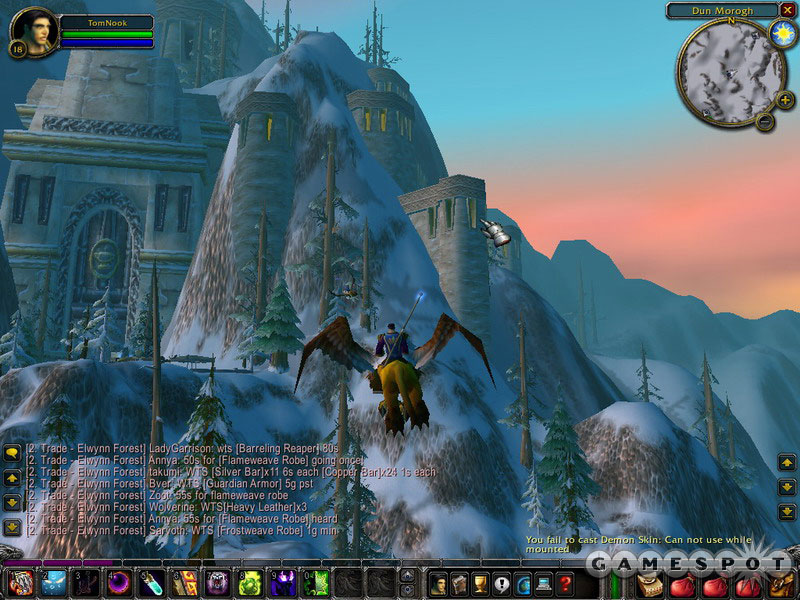
The interest surrounding the game stems from a number of factors. One is that Blizzard, while known for producing quality games, has never developed a massively multiplayer online game. Blizzard does have experience in providing an online matchmaking system for tens of thousands of Starcraft, Diablo, and Warcraft III players simultaneously on Battle.net. But creating a fast, stable environment for an MMO game is a whole lot different, as many larger companies would attest. Another reason for the interest is that this will be the first commercially available game set in the Warcraft universe that isn't a real-time strategy game.
Longtime Blizzard fans may remember that the company attempted such a venture shortly after Warcraft II, with a game called Warcraft Adventures. Blizzard eventually canceled the game, citing dissatisfaction with the slow pace of that game's development. In light of that, Blizzard faces some interesting challenges with World of Warcraft, which will be stacked against a couple of next-generation MMO games, such as Sony Entertainment's EverQuest II and NCsoft's Lineage II. Both of those games promise to be more technically advanced than World of Warcraft will be, and obviously each company has the benefit of years of experience with MMO games under its belt.

A number of GameSpot editors have taken the opportunity to participate in the World of Warcraft beta test. We've already posted a quick first impressions piece, but after a few weeks of play-testing, we've each formulated some opinions on the game, coming from a number of different points of view. In this feature, you'll hear about how the game is paced, how the art style sets it apart from the crowd, how longtime players of Blizzard games may react to seeing the Warcraft universe from a different perspective, and more. Perhaps most importantly, you'll hear how the game stacks up compared to existing MMO games, from the perspective of an editor who's tried just about all of them and has "been there, done that."
Jeff Gerstmann |
"The Impatient Gamer"
World of Warcaft certainly isn't the first massively multiplayer game to hit the scene. And many of the things that the game does are things that other, similar games have been doing for years now. But for me, the thing that sets World of Warcraft apart from the pack is its pacing.
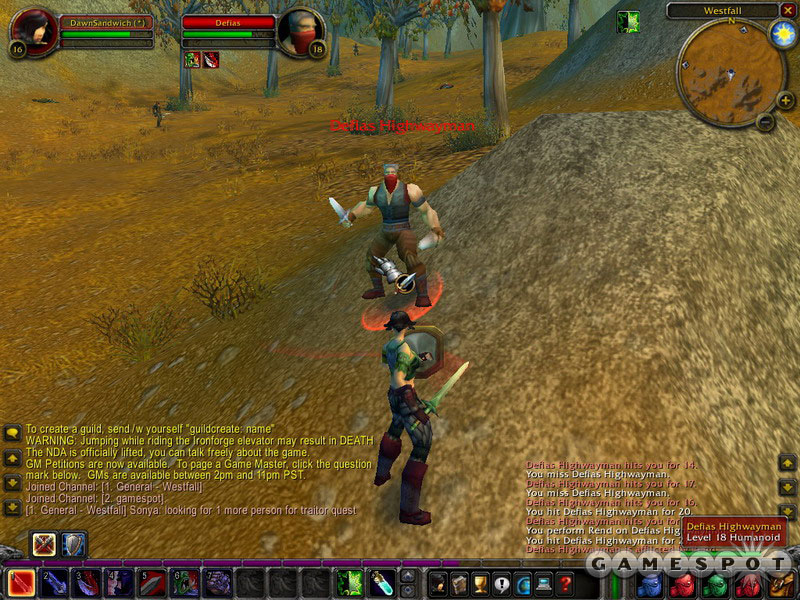
In most massively multiplayer games, there tends to be a pretty hefty downtime in between all of the heavy action, especially when you're first getting started. World of Warcraft is paced in such a way that you can move from one battle or quest to the next with minimal downtime. The sort of downtime found in most massively multiplayer games is what has kept me from becoming anything more than a casual player when it comes to massively multiplayer games.
In my own personal case, I've chosen to play as a warrior. Typically, warriors working alone need to either stock up on items or plan to do a lot of camping. In World of Warcraft, your health regenerates pretty quickly when you're outside of combat, so unless you're planning to take on three or four guys at once, you can usually go from battle to battle and only have to take a break after you've taken out a few guys. To streamline things even further, those breaks are usually pretty short. Once you've been playing for a while, you'll have to recover a lot more hit points. That's when food becomes handy. You can't eat food during combat. It basically helps you regain health more quickly while sitting down. If you're working in a group alongside a healer, you don't really have to stop for anything, provided you're not biting off more than your group can chew. Spellcasters' mana regenerates just like health does, and this means that you shouldn't have a problem getting protective barriers or heals from the support roles in your party.
So that's great for basic combat. But the game's pacing is also helped by the quests that you receive. You'll begin the game in a low-level area, and you'll take on some basic quests. Eventually, you'll get a quest that leads you to another town in that same general area. There, more quests await, and you'll eventually run off to the big city in your area--in my case, as a human character, that's the city of Stormwind. After questing around in your starting zone and becoming a somewhat more powerful character, you'll get a quest that requires you to leave that zone and head to another. There? You guessed it, even more quests. The quest design keeps you on a specific path and guides you toward the next logical area to work in. It eventually opens up quite a bit, too. At the moment I've got various quests going in three or four different zones. The game's quest log breaks your list of quests up by zone, which makes what can be a hefty list much more manageable.

While the game's been great at giving players enough to do to stay motivated without ever really feeling like a simple treadmill designed to suck monthly monies out of your wallet, it still does come along with some of the conventions of the genre. If the rest of the game were more standard, these things wouldn't stick out as much, but they're there, and I still find them a little troublesome. For example, quest-specific non-player characters appear on a timer. In Elwynn Forest, there's a pig named Princess that you must whack for one of your quests. But run to the area where Princess supposedly lives and you'll usually find a handful of players, camping out, waiting for the next incarnation of Princess to spawn. Head over to Westfall and you'll find players camping out in search of a messenger or camping out while waiting for a Defias traitor to appear and guide them to the thieves' headquarters. While longtime fans of the genre aren't strangers to this practice, it feels as out of place here as it does in other, similar games. In fact, given the rest of the game's fast-moving pace, having to wait around for some dumb gnoll boss to reappear feels really out of character. It's my hope that the developers can find a way to get around this waiting game, as camping out at various respawn points is really the only waiting game that World of Warcraft has.
So is World of Warcraft fun? Sure it is! It feels like a good deal of care has gone into the low-level content to ensure that players learn what they need to learn about playing the game, and it gives you plenty of fairly interesting things to do, from quests to trade skills. But will that strong first impression translate into an EverQuest-style addiction? Will it pull people away from their massively multiplayer game of choice? Of course, we'll have to wait and see how the final game turns out. At the moment, it's a pretty easy game to like, but it's going to take a lot more unique content to truly separate World of Warcraft from the pack.
Brad Shoemaker |
"The Addict"
Addiction, World of Warcraft is thy name.
That was the thought running through my subconscious roughly two weeks ago, when I was something like 72 hours into an obsession that has so far shown no sign of abating. That's hours in the real world, not game hours, although it might as well be. I did in fact play World of Warcraft for about 30 hours the first weekend I was in the beta, which I think is probably the highest ratio of playing time to non-playing time for a given span in my entire gaming career, which started about 20 years ago.
Anyway.
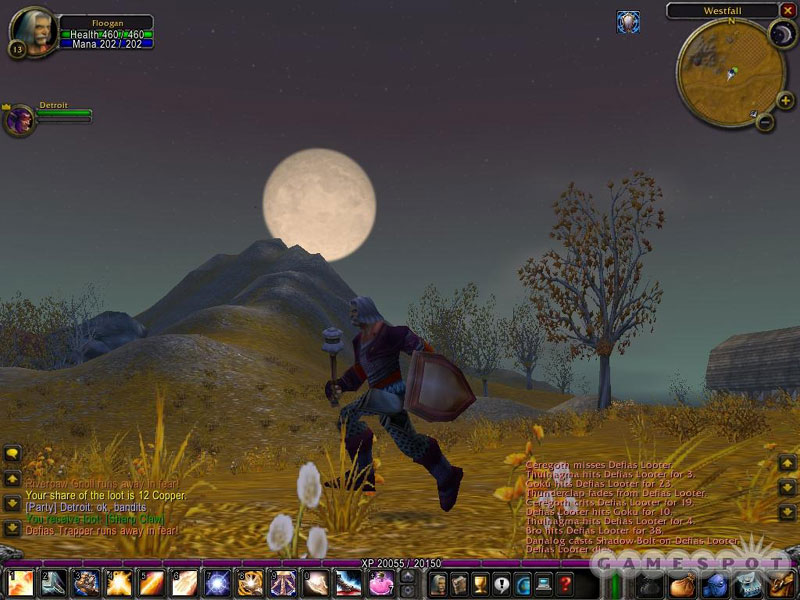
What is it about this game that has me so addicted? For a lot of old-school MMORPG players, much of the appeal will be old hat. I've really never played an online RPG--for one, because I haven't thought any of them looked very appealing, and for another, because I didn't want to make the enormous time commitment. As great as it is, World of Warcraft is just another MMORPG at heart. So getting into the game for the first time, I was totally wowed by and enamored with the same things that you longtime players take for granted--the character-building mechanics, the continuous, persistent world, and the ludicrous number of things to do. You know, The Game. As a newcomer to the MMO genre, I was blown away by how much bigger this game seemed than anything I've played offline. But yes, I know, all MMOs have these things in varying manners of presentation--thanks for telling me.
Old hat or not, though, this is a Blizzard game, and let me make this comment, trite though it's fast becoming: Even in its early beta state, this game is polished to a truly wonderful sheen. I can't remember a single moment I've spent playing the game when I wasn't happy to simply run around the lovingly crafted worlds and appreciate the fine details Blizzard's artists have imbued them with. But here's the thing: I never had to just do that. There's always something else that I can do, always half a dozen quests to complete or items to buy or skills to master. Doing quests leads you to find more quests. Perfect a skill, discover three more to work toward. This game is bursting at the seams with stuff, and I can't seem to get enough of it.
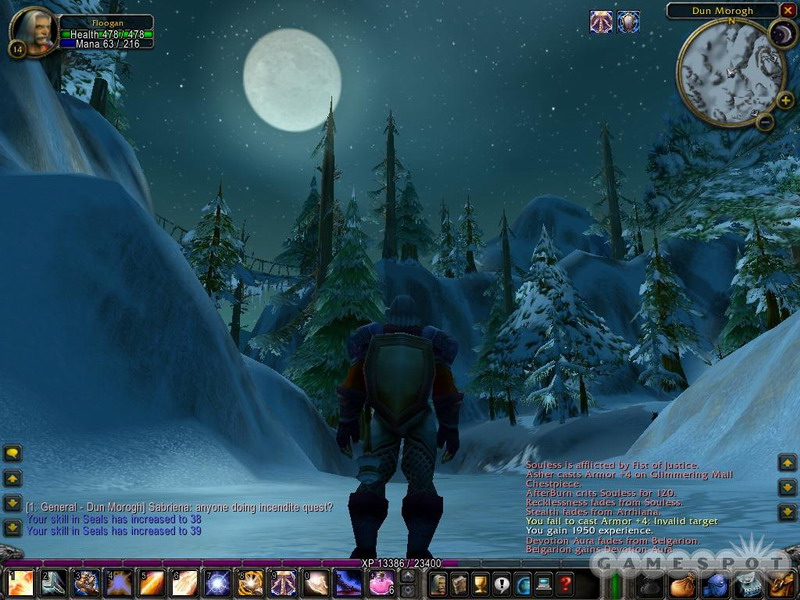
Attendant to World of Warcraft's success--from a design standpoint, not a financial one--is the amount of charm Blizzard has managed to give this game. I think that's as essential a component of my addiction as are the engrossing (and seemingly endless--I'm still not aware of all the trade skills) game mechanics. I've traveled only a minor fraction of the world's total landmass and seen a very tiny portion of the game's total content, and I'd swear I've already encountered more personality in the lands and the quests and the people than I've seen in many whole games. Something about the cohesion of the names, the way quests spill over into other lands; it all just feels like a real living, breathing world. Maybe it's the way you never hit a loading screen--I don't know. The game just sprawls for miles and miles, and every inch of it is quality.
I remember when World of Warcraft was first unveiled, Blizzard's big line was that it would be the first MMORPG that you could play for just an hour and still have a great time with. How ironic that playing this game for only an hour is damn near impossible.
Ryan Davis |
"The Art Critic"
Graphics mean a lot to me, but not necessarily in a technical sort of way. Frankly, stuff like next-generation graphics engine demos bore me. In the end, I don't care about the behind-the-scenes technology--if the actual composition of the characters and the environments shows no care or creativity, I have a hard time getting enthused. World of Warcraft is technically impressive, no doubt, but what has continually taken my breath away is the quality of the game's graphical structure. Simply put, WOW is probably the most visually stunning online RPG I've seen.

One of the basic jobs of an MMORPG is to create an environment that the player can really believe. It's a hackneyed and obvious reference, but as in The Matrix, people won't accept a flawless, uniform world as being real. Blizzard seems to get the importance of creating a natural, organic world.
Take Stormwind City, the human capital and currently the main traffic and trade hub in the game, for example. The city seems to conform to the contours of the landscape beneath it. Streets twist and turn, random alleys lead to dead-end cul-de-sacs, and straight lines are almost nonexistent. It's actually really convoluted, and on your first visit, it's likely that you'll find yourself good and lost, which can be frustrating if you're trying to complete a quest, but it lets you discover Stormwind as you might an actual city--by just wandering around. The first time I gave another player directions based on specific landmarks, I understood just how purposeful the geographical layout in WOW really is. Subtle, mundane details like these make the world believable.

By basing the core visual language on the unique, exaggerated high-fantasy style that Blizzard really perfected in Warcraft III, it's able to insert some really grand, breathtaking set pieces, such as the massive statues in the Valley of Heroes that you pass as you enter the gates at Stormwind, without their seeming out of the ordinary. I'm most smitten with what Blizzard has done with Stormwind in particular. But the other areas I've spent time in, such as the native night elf island of Teldrassil, with its midnight palette and pervasive, mile-high forest canopy, or the rolling hills and auburn tones of the perpetually autumnal Westfall area, give an equally strong sense of location. No matter where I've been so far, I've always felt like I was at a place and not just some randomly generated patch of land.
I'm sure my giddy fanboy enthusiasm is coming across loud and clear, and I haven't even gotten to the fantastical range of creatures you'll encounter (the massive treelike ancient protectors on Teldrassil are definitely the most stunning I've seen so far). The point that I really want to drive home here is that Blizzard has created a diverse but cohesive world with WOW, one that seems far less abstract than any that have come before. The best part is that I've seen only a fraction of the areas that are currently open for exploration in the beta, the sum of which represents only half of the game's final landmass. If the undead, tauren, and orc regions can live up to the same level of craft as I've borne witness to in the night elf, human, and dwarf regions, World of Warcraft is going to be one tough act to follow.
Bethany Massimilla |
"The Good Samaritan"
The priest is quite possibly the very best class in World of Warcraft. That statement's thoroughly steeped in my many, varied experiences with my own (currently level 17, thank you) character, so perhaps it's better to say that, for me, the priest is quite possibly the very best class in the game. The reason for that is closely tied to the way that I approach MMORPGs and how World of Warcraft lets me realize that approach in a meaningful way. To put it directly, I like to help other people out. No, I love to help other people out. Sure, I also enjoy running to and fro all by my lonesome, smacking critters with my mace, but there are zillions of games that exist that let me run around by myself. Priests are awesome because they can solo effectively as well as be that person who, in a group, is in charge of keeping everyone else alive. Healers are popular. Who doesn't like being popular?
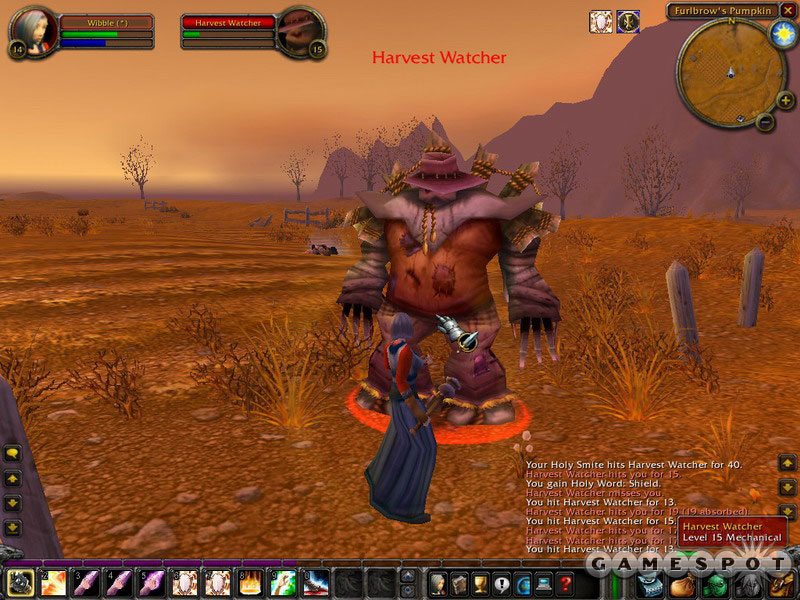
I never play in a vacuum--even when I'm soloing, I'm never really solo. I'm constantly looking at other players around me to see how they're doing. Is he going to be able to take that bandit by himself? Is she going to be able to draw that murloc out from the pack, without bringing along four of his friends? (Note: The answer to the previous question is always "no.") Is anyone running, precariously low on hit points, trailed by a determined foe? If I'm not actively involved in battle, I'm constantly dishing out heals, shields, and stamina-boosting spells to nearby folks in need. It's a priestly thing to do, and nothing beats those warm vibes you get when someone says, "Hey, you saved my butt. Thanks!" Such acts can even end up encouraging reciprocal treatment, as occasionally that person I healed five minutes ago helps me polish off a tough monster when I'm out of mana and down to my very last sliver of heath. It's a good way to make new friends, as well, and I've helped random people out only to end up grouping with them several levels and days later.
I've never had trouble grouping in World of Warcraft, and, as a matter of fact, I've never really had to request to be added to a group. Oftentimes, I'll head to an area with tough enemies, pause to scout things out and weigh my chances, and end up with an invite from a nearby party. People will also shower me with potions and drinks to help replenish my precious mana, a gesture that is at once altruistic as well as self-serving, but it's always much appreciated, as I've not yet learned how to make my own potions to quaff. I always feel slightly guilty in those instances, as the only things I can make right now are shirts in attractive colors, but people never seem to mind. In turn, if I've picked up something nice in mail or leather armor, or a cool weapon, I'll generally offer it to a teammate who can put it to good use. Generosity seems to be contagious in groups, where people will, in my experience, routinely stick it out and spend the time to help other party members grab those last few quest items, kill that certain monster, or gain that one level.
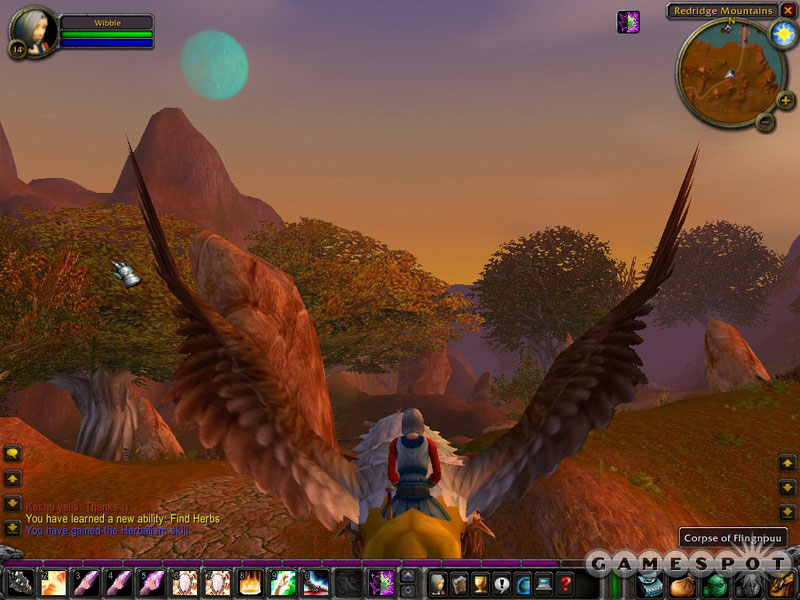
Being grouped is the natural environment for a support class, but I never feel restricted to certain activities, as the priest's spell suite lets me contribute just about everywhere. If someone's taking major damage, I can throw out a shield that absorbs that damage and then a heal to patch him or her up; if we've drawn too many monsters, I can put the extra ones to sleep until the group is able to deal with them; if we're fighting a high-level beastie that eats up hits, I can cast a spell that unleashes damage over time, or, mana allowing, I can beat the baddie up with holy smite; I can even, if I feel like it, walk right in and melee with the rest. I love the versatility of the class, I love the utility of the class, and I wholeheartedly love being in a position where my actions can directly, positively impact the experience of other players. I'm thoroughly addicted to being the good Samaritan and thoroughly addicted to World of Warcraft, and I always look forward to grouping up and helping out the next time I'm online. When this game finally goes to retail, you can bet I'll be on board with a priest, running around and looking for people in need. I adore my class, and I adore this game.
James Yu |
"The Alpha Tester"
I actually passed on the chance to try the World of Warcraft alpha the first time I heard that a friend at Blizzard was looking for testers. I was happy with my 9-to-5 job and nightly Counter-Strike sessions.
A week or two later I had the opportunity to watch a friend play the alpha version. I only planned to watch for a few minutes, but I ended up staying for two hours, just watching as he killed boars, collected wendigo manes, and completed a variety of quests. The game had me hooked, and I hadn't even touched the controls. I contacted our mutual friend at Blizzard the very next day.
My first impression of the game was that it felt polished from the start. It took less than 15 seconds to load the game and log in to the server. I missed the human push and joined halfway through in the dwarf push, but if I had to judge by the areas I had played in those first few days (while ignoring the few item and text placeholders), I could have mistaken the alpha for a shipping version.
Since I was a few weeks behind the rest of my friends, I ended up soloing and exploring much of the game on my own as I caught up in levels. I started partying with my friends when I reached level 20, and I have to admit that those first forays weren't pretty. I was a mage with very little group experience. When you solo as a mage, the goal is to kill the monster as quickly as possible before it shreds through your armor, but it took me a little while to drop my battle-mage mentality in the group environment. I had to learn how to manage my damage dealing to avoid drawing monster aggro away from the group tank. Our priest must have wasted countless mana potions healing my newbie mage.
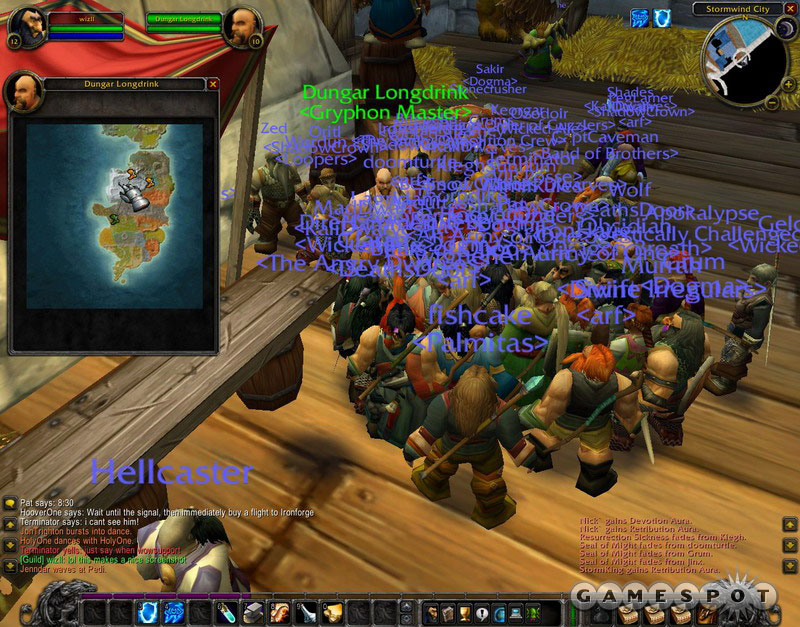
One of my favorite events during the dwarf push was the night of the mass gryphon flight. The developers were trying to track down a bug that they suspected was caused by having multiple characters ride the gryphon at the same time, and they asked the players to help with a test. Everyone gathered in Stormwind at the appointed time, with the GM teleporting players in as needed. The human GM looked like a male Snow White surrounded by at least 50 dwarves.
I only played the undead push for a week since my system couldn't handle the number of players clumped around the early cities during the initial release, but I upgraded my memory to 768MB just in time for the tri-horde push.
The tri-horde push opened the orc, troll, and tauren races and lasted a very, very long time, revealing a number of gameplay issues. Blizzard added corpse retrieval to the death system because players started abusing the bindstone system. Back then, players could respawn at their bindstone without an experience penalty after dying. If you wanted to get back to town quickly, "deathgating" was the fastest option. There was a small pond in the tauren Thunderbluff City that was always full of drowned players. That still didn't stop players from fishing the pond.
We also saw the rise of the "big warriors running around with little knives" phenomenon when players realized that fast weapons are able to deal a lot more damage than slow ones due to weapon damage modifiers that add a sizable bonus with each hit. Warriors left and right started dropping their swords, axes, and maces for daggers instead.
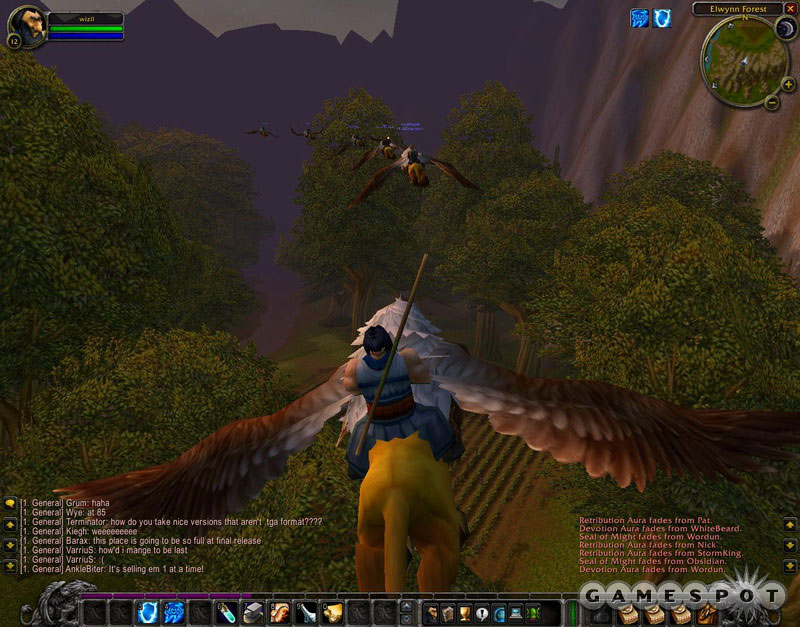
As the tri-horde push went longer and longer, more and more players hit the level cap, and we saw a real divergence in player activity as people struggled to deal with life after XP. Many players turned to fishing in hopes of pulling a rune sword, the best level-30 weapon in the game, out of a locked chest. It would be common to see several players sitting on the same rock fishing for hours at a time, only coming back into town to sell fish, clams, pearls, and occasional rare items pulled from the sea. It got to the point where the best fishing pole in the game started selling for elite item prices, up to 10 gold.
Other players became explorers, trying to get into unfinished areas protected by Guardians of Blizzard. A physics exploit allowed players to climb mountains with a lot of determined jumping and air movement. Some players would give running commentary in the general channel as they explored new areas. I knew one player who spent days trying to figure out a way to swim to the other continent. You'd see him in the trade channel asking to buy water-breathing potions. He detailed his plan to me once--something about swimming to the ocean floor and running along the bottom where there was a bug that allowed you to breathe. I gave him a stack of swim-speed potions and wished him luck.
The alpha players celebrated the end of the tri-horde push with a mass rave in the Crossroads that moved to the ship in Ratchet and ended with an attempt to take down a Guardian of Blizzard. I think the Guardian won.
Bob Colayco |
"The Warcraft Player"
I was an avid player of the Warcraft series long before I started working in this industry. I've played and enjoyed Warcraft III, Warcraft II, and even some of the original Warcraft. So when Blizzard announced World of Warcraft in 2001, I was naturally very interested in the game, despite the fact that I've never been a fan of the MMO genre.
Leveraging a strong brand and turning it into an MMO game has been tried before, with mixed results. Neither Star Wars Galaxies nor The Sims Online has been the smashing success that their respective publishers had hoped for. And both of those brands are probably more recognizable and appealing to a broader audience than the Warcraft name. While the struggles those games had at launch are largely attributable to bugs, a lot of it had to do with a lack of content and things for players to do. As Jeff and Brad have already attested, World of Warcraft in its current state does a good job of giving players plenty of interesting quests, at least at the lower levels. But how closely do the things you do and see relate to what Warcraft veterans are familiar with?
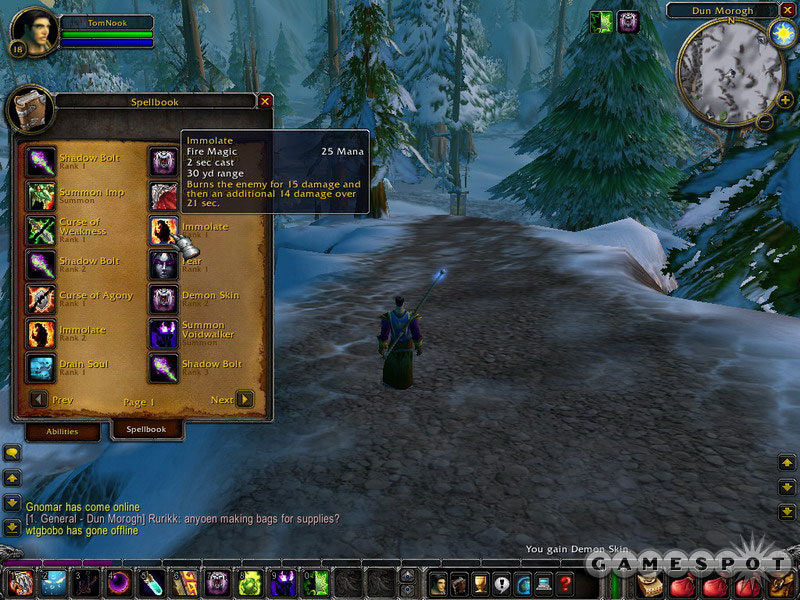
As far as giving the player an "authentic" Warcraft feel, World of Warcraft does an admirable job for the most part. Right from the start, the icons you see in your spellbook and in your quick tab should be very familiar to you if you've played Warcraft III, as a good number of them are recycled. For example, the paladin's holy light spell uses the same praying hands icon as in the RTS game. While you'll certainly be using spells and abilities that weren't in previous Warcraft games, maintaining at least some familiarity contributes in a positive manner to the game's accessibility.
Beyond the interface conventions, many of the enemies and NPCs you meet up with early on will be familiar to Warcraft players. At the newbie human areas, you'll see footmen patrolling the roads and protecting travelers from monsters that wander too close to the paths. Low-level human players can also expect to deal with aggressive kobolds, doglike gnolls, and amphibious murlocs, all of which appeared as "creeps" in Warcraft III. The murlocs in WOW aren't nearly as easy to dispatch as they were in Warcraft III, though.
Upon reaching level 16 or so, I finally encountered orc grunts and ogres for the first time in WOW. These guys have characterized the Warcraft franchise for years, so it was quite interesting to see them from a new, more up-close perspective. Of course, that sense of wonder dissipated quickly after getting pounded into a pulp by them, but it was fun to see them regardless.

The varied architecture and settings also factor greatly and will be recognized by Warcraft veterans. As in Warcraft III, you'll see murlocs in WOW congregating around straw huts elevated on stilts at the edge of bodies of water. I knew immediately what type of creatures I'd find as soon as I saw the characteristic hovels appear on the horizon next to a lakeshore. The human settlement of Goldshire features a blacksmith building with giant, moving bellows, just like the ones in the RTS games, while the city of Stormwind is very much inspired by the human castles of Warcraft II and III with their tall spires and gleaming white walls. In other areas of WOW, as you raid orc camps, you'll notice spiked barricades around their primitive structures that closely resemble orc buildings from the RTS series.
Unfortunately, some things get lost in the translation. One of the defining characteristics of Blizzard games has been their excellent voice acting, which adds charm and personality. The acknowledgements "zug zug" and "daboo" entered the lexicon of more than a few gamers during Warcraft II's heyday. It's too bad that there appear to be no voice-overs in World of Warcraft, so having quests presented to you with just plain text can be a little disappointing to a Blizzard fan, even if the writers have attempted to inject a little flavor here and there into the dialogue. It also remains to be seen how the game will maintain its ties to the core Warcraft universe as players reach higher and higher levels. After all, we've seen only a fraction of the total land area available to explore in the world. How will the rest of the game look? Will the powerful and fearsome gryphons of Warcraft II remain nothing but glorified taxis in WOW? Where are the goblins? For the answers to these and other burning questions, we may have to wait for the retail launch.
Andrew Park |
"The MMO Veteran"

I'm going to have to choose my words carefully on this one for a number of reasons. For all the people who have actually followed my career and read all my articles--both of you (thanks Mom and Dad)--you may know I've always tried to be as evenhanded as possible, especially when dealing with prerelease games that aren't even done yet and may not be representative of the final game. Which is exactly what we're talking about here. Anything and everything you read about World of Warcraft, including this feature, could change drastically by launch, if Warcraft III's, Frozen Throne's, Diablo II's, Starcraft's, and Brood War's betas (which ended up changing drastically in the last few weeks before the games were done) are any indication.

Please understand that even though I've cracked a joke or two in the past, I have great respect for Blizzard as a developer, though every time the studio releases a new game, I find myself in a situation like this one. Back in 2002, after Warcraft III came out, I was discussing that game's single-player campaign with a colleague--specifically, the human campaign in which Prince Arthas recovers the "cursed runeblade Frostmourne" (a weapon that, according to the opening cutscene in the undead campaign, "steals souls,") to battle a great evil. The sword turns him into a cynical, white-haired antihero who indifferently butchers his enemies. Arthas then returns to his home kingdom, only to destroy it. If you're half the nerd that I am, you'll immediately recognize the obvious "inspiration" drawn from Michael Moorcock's Elric Saga novels, which starred one of fantasy fiction's most well-known antiheroes: Elric of Melniboné. Elric was also a cynical, white-haired prince, who recovered a "runeblade" called "Stormbringer" (the twin of another runeblade called "Mournblade"), also to battle a great evil. This sword also stole the souls of its victims, and as part of his adventures, Elric also returned to his homeland and razed it to the ground. Now, my colleague isn't half the nerd that I am, and so, through no fault of his own, he knew absolutely nothing about Moorcock's Elric. So, he argued that whatever similarities I saw must have been due to a combination of sheer coincidence and Blizzard's own ability to craft an interesting story. We went back and forth for a few minutes, then I gave up, because I realized it was a pointless discussion.
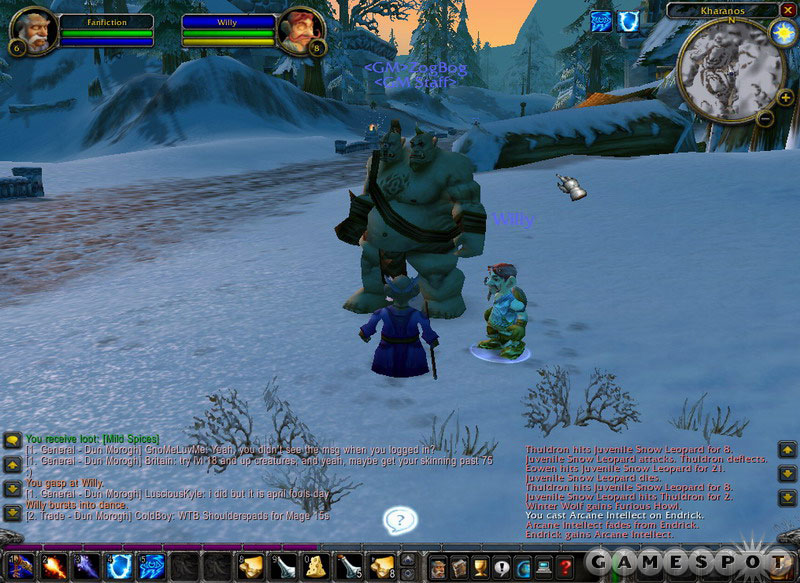
I find myself in a similar situation now with the World of Warcraft beta. While our good friends at Blizzard dutifully provided several members of the GameSpot staff with accounts, they also graciously accepted my follow-up requests for other editors to join the beta. While everyone was pleased to participate, regrettably, some have no, or next to no, experience with massively multiplayer games. As you might expect, the office is now constantly abuzz with staffers excitedly discussing their latest adventures in World of Warcraft--how their characters just gained a level, completed a tough quest, found a skilled crafter character to sell them some armor on the cheap, or ran afoul of powerful monsters and nearly died from the resulting "train," an angry group of monsters that will chase you down if you don't carefully draw them out individually or subdue their companions. Yet these are all things that massively multiplayer online RPG veterans were doing five years ago in Sony Online Entertainment's groundbreaking game from 1999, EverQuest, and in some cases, for years before that in text-based "multi-user dungeon" (MUD) role-playing games. During the past few weeks, I've heard plenty of spirited testimonials on how incredibly addictive World of Warcraft's hack-and-slash gameplay is. My response has usually been to smile, nod, and reply, "Yes, that sounds like an online RPG all right." A few have enthusiastically rebutted with, "No, I've played online RPGs before. I mean, one time, I tried (a previous online RPG) for five minutes and got sick of it, and I also watched my roommate play (another previous online RPG) for six months, and this is totally different!" Again, I respectfully agree to disagree and let them get back to discussing how, for some reason, it seems like they're not advancing in levels as quickly as they used to.

Please understand that I don't begrudge my colleagues' enjoyment one bit. That is, if you've read this far, you may already be thinking, "So what if it's familiar ground. If the game is fun, then who cares about anything else?" And I agree with this because, like you, I believe that for the most part, if a game isn't fun, it shouldn't exist. It's very gratifying to see GameSpot editors all enjoying a PC game--especially editors who have typically preferred console games. I think that World of Warcraft's accessibility, both in terms of its gentle learning curve and its modest system requirements, should help it gain a lot of loyal new followers at launch (if Blizzard can get the game into the hands of more beginners).
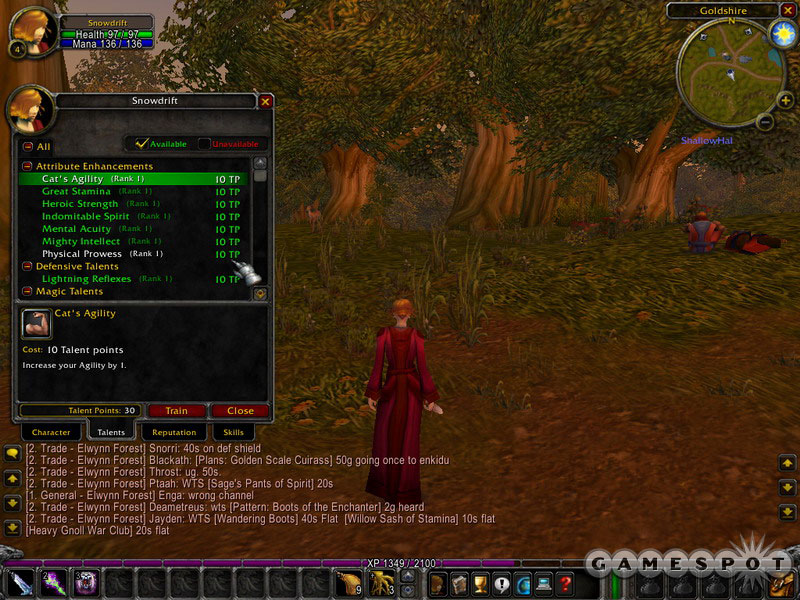
I have to think that Blizzard faces a unique challenge with World of Warcraft. While the company has always experienced great success in studying the mistakes of previously released, competing games, then has learned from them to release a refined and polished product, online RPGs are considerably different from Blizzard's traditional strategy games. Competing online RPGs have been around for years and have thousands of loyal fans who not only enjoy those games, but also have a strong emotional commitment to these games because they've invested countless hours of time and effort into their characters and have also built up a network of friends in those games. While waiting for the other guys to ship first and slip up and then trying to avoid making the same mistakes has worked well for Blizzard in the past with other games, the much-beloved developer will be requiring the same thing that all of EverQuest's competitors did and still do--that loyal fans of other games tear themselves away from the incredible amount of time and effort they have spent building up characters, guilds, and real friendships, to start all over again from square one.
Got a news tip or want to contact us directly? Email news@gamespot.com
Join the conversation